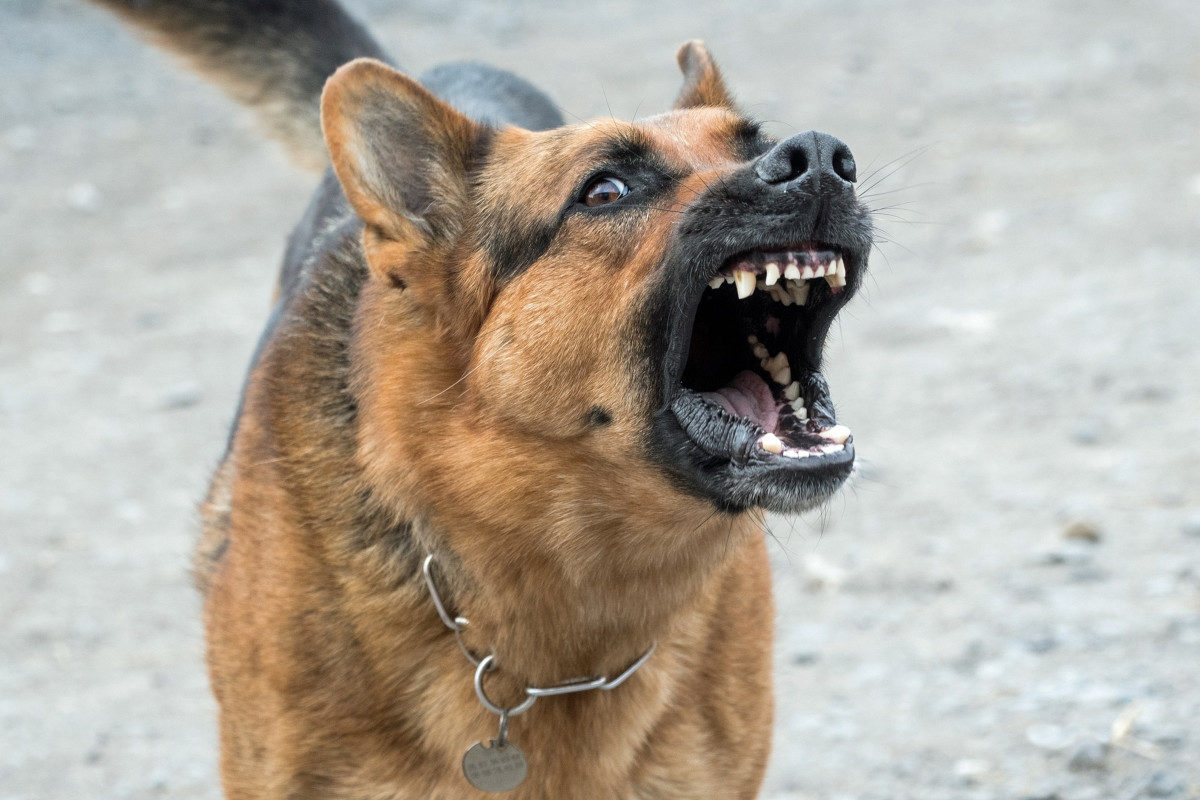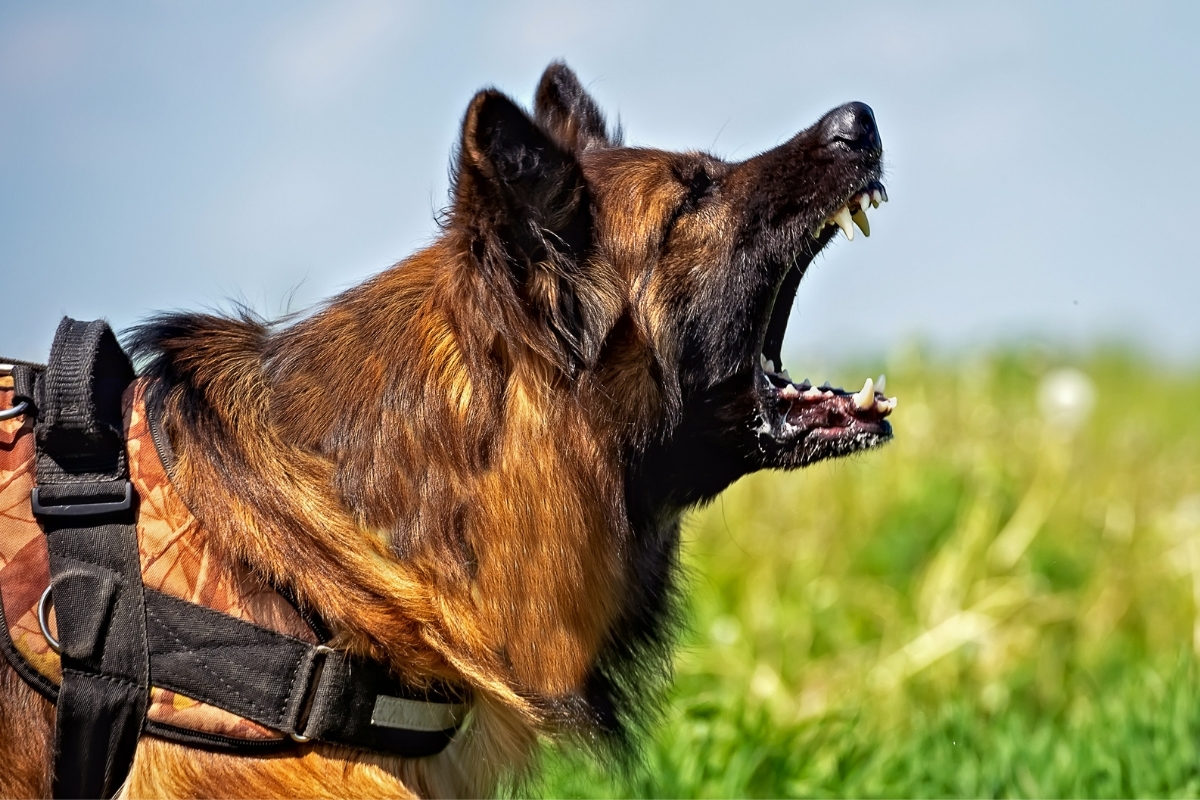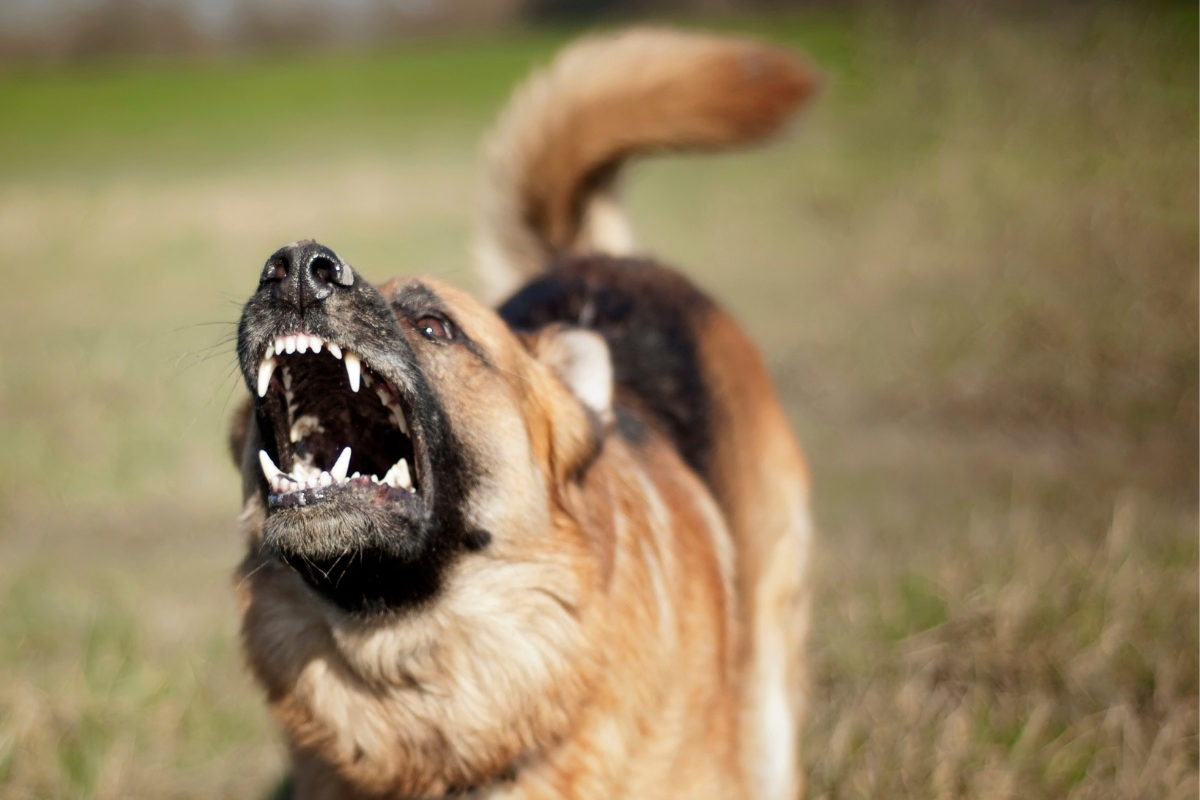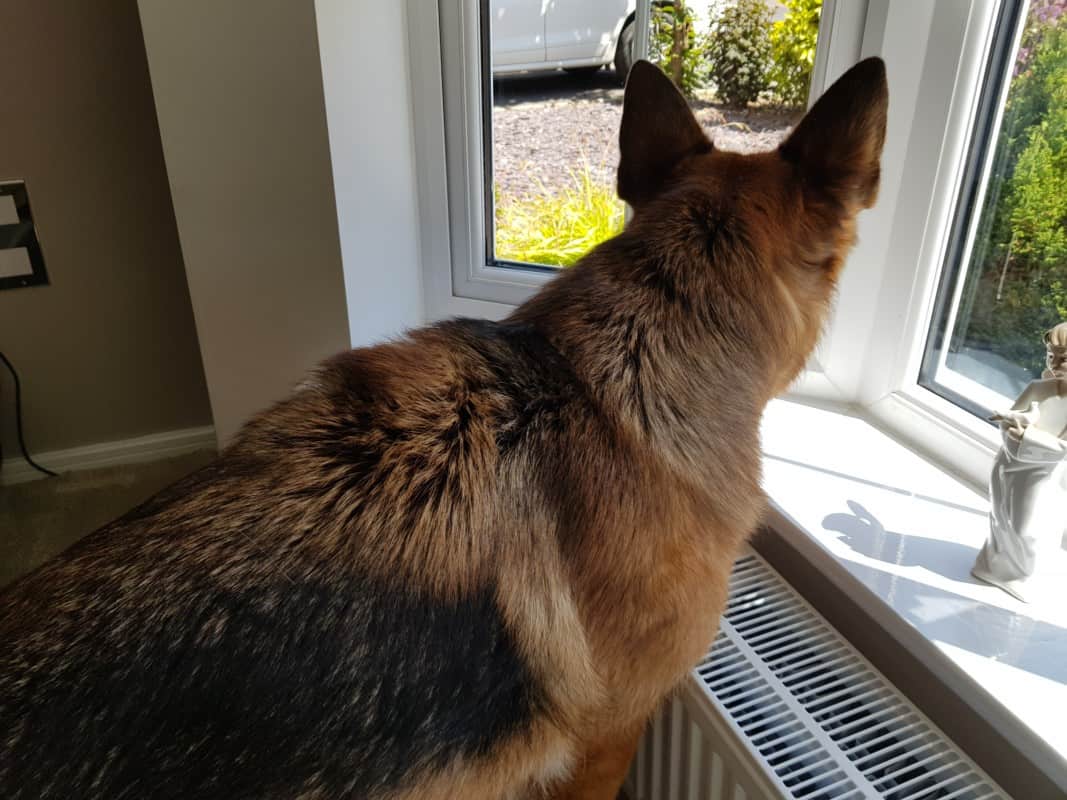German Shepherds are a popular dog breed known for their intelligence, loyalty, and protective instincts. However, they also have a reputation for being aggressive, which can be a source of concern if you’re considering getting this breed as a family pet. So before making your decision, you might want to know if German Shepherds really are aggressive.
German Shepherds are generally not aggressive towards their owners or family members as they are protective of them. However, they can display aggression and overprotective behavior if they feel threatened. But with proper training and socialization, German Shepherds can be loyal and loving pets.
In this article, we will examine the risk factors associated with German Shepherd aggression. Additionally, as the owner of a German Shepherd, I will provide useful tips for dog owners seeking to prevent aggression in their German Shepherd in the first instance.
Let’s debunk the myths about German Shepherd aggression!

Are German Shepherds Aggressive Dogs?
German Shepherds can be aggressive dogs if not socialized properly. This is because their protective instincts are natural, but their social tendencies are learned. A GSD who isn’t taught what constitutes “normal” can be on high alert during regular activities and nurse an aggressive edge in general.
German Shepherds used to protect sheep from wolves. Now, most live in homes as pets. Still, they instinctively sort organic beings as “worth protecting” (sheep) and “worth keeping at bay” (wolves), allowing them to balance friendliness with caution.
Nonetheless, you must sufficiently socialize your German Shepherd and expose him to people and experiences at a young age.
When he is a puppy, people will not be as nervous around him, which is great for his self-esteem and his perception of humans in general.
But if he grows up asocial, how he carries himself will put people on edge, which will also reflect in the dog, kicking off a negative feedback loop that makes your German Shepherd more aggressive. To avoid unintentionally triggering such a loop, you must first know what causes a German Shepherd to be aggressive.
Due to the high intelligence of German Shepherds, they can be trained to show aggression and bark on command. This is why they are used in law enforcement and as guard dogs.
In my policing days, I loved watching the dog handlers command their dogs to “SPEAK” and see the reaction of the baddies. Let’s just say they soon did as they were told!
Learn More About The German Shepherd In This Video…
Why Do German Shepherds Become Aggressive?
The reasons for German Shepherd aggression can be broadly classified into two categories: fear and frustration. This recent study of 9000 dogs found that dogs’ aggressive behavior towards humans is often caused by fear.
However, the sources of fear and anxiety are the real culprits, and they can be further broken down into the following reasons for German Shepherd aggression:
- Pent-up energy
- A defensive mechanism
- Sexual maturity
- Poor training
- Health reasons
Let’s look at these in more detail.
Pent-up Energy
Given that German Shepherds are large energetic dogs, the likeliest contributing factor to your German Shepherd’s aggression is his pent-up energy. If you have previously had pets of medium or smaller size, you might be used to lower activity levels.
The same applies if the German Shepherd is your first dog. Unless you have had a big dog before, you will almost always underestimate the exercise demands of the breed.
“That’s why when a GSD acts aggressively, the first thing most dog trainers look at is the dog’s activity levels.”
Even the most well-trained dog can act out if he has too much pent-up energy. He will no longer override commands or ignore etiquette upon exhausting this energy. Taking the dog on a long walk is a straightforward way to channel this excess energy safely.
That said, you must create a 10-minute break between his display of aggression and exercising him because the last thing you want is for your German Shepherd to start associating aggressive displays with reward.

Defense Mechanism
If you’ve adopted your German Shepherd from a shelter and he is a rescue, then chances are his abusive past may have set him up to rely on aggression as a default defense for normal stimuli. Let’s suppose his previous owner abused him when he barked at the doorbell.
Now, he gets aggressive anytime he hears a doorbell because the association has taken root, and he is in fear.
Unfortunately, a German Shepherd forms most of his lasting associations when less than six months old.
That means any older rescue dogs will require a lot of patience to have aggressive defense mechanisms deactivated. It is advisable to use the services of a professional dog trainer if your rescue seems to be aggressive because of PTSD or trauma.
In the meantime, avoid being harsh with punishments and do not opt for negative reinforcement as a mode of discipline. Read more on exactly how to discipline a German Shepherd.
Sexual Maturity
After pent-up energy, this is the second most significant contributor to a dog’s aggressiveness. While sexual aggression is often associated with the male gender, even female German Shepherds get aggressive when in heat. Spaying or neutering your German Shepherd can resolve aggressive displays that occur because of sexual maturity.
Nonetheless, before you get your dog snipped to resolve his anger issues, you must be sure that the aggressiveness is indeed a result of sexual energy and talk to your veterinarian first.
It helps to look at the aggressiveness levels over a longer period. Suppose the levels of aggressiveness correlate with development and sexual maturity (5 to 6 months) and are inconsistent across a few weeks. In that case, you can be sure that this is because of the changes in their body.
Sexual aggression can be of two kinds. The first is a result of frustration. It is also the assumption that makes owners wonder whether male German Shepherds are more aggressive than females.
So, what’s the deal?
Male German Shepherds are more aggressive than females in general, but females tend to be relatively more aggressive during periods of heat. Males remain more dominant even after neutering, while female GSDs lose the bulk of their aggression upon getting spayed.
Related: How to Train an Aggressive Female German Shepherd.
The aggression related to sexual frustration isn’t even a problem one has to manage as it is one vet visit away from being neutralized.
That brings us to the second kind of sexual aggression. When a GSD undergoes sexual maturation, internal changes in their body make them feel anxious. This isn’t sexual aggression but a health-related aggressive behavior that correlates with sexual maturity.
Health Problems
As covered above, some part of sex-related aggression comes from the dog being bothered by internal changes that they don’t know are normal. If your German Shepherd has matured sexually or hasn’t even reached puberty, he can still have internal changes, making him anxious.
Internal changes can be temporary (when the dog gets sick) or permanent in reaction to environmental changes around the dog. Either way, German Shepherds are not the best at handling change, internal or external. Showing compassion and making sure they have more routine in their life can help reduce these aggressive tendencies.
Poor Training
Some aggressive behavior seems abnormal because it is conditional. A German Shepherd might be perfectly well-behaved throughout the day but start being aggressive around strangers. Even if this doesn’t happen all the time, inconsistent aggression is a sign of a poorly trained dog.
German Shepherds descend from a line of highly disciplined work dogs, making it pretty hard for them to be unpredictable even with average training. However, if an owner gives mixed signals unknowingly, he ends up with a well-behaved GSD who seems to act out unpredictably at times.

If you’ve ever asked yourself, “why is my German Shepherd aggressive towards strangers?” then you probably have a German Shepherd that needs better training. But don’t be too harsh, as you should also remember that it’s in the breeds’ blood to be aloof with strangers due to their natural protective instinct.
Your German Shepherd is aggressive towards strangers because he is not socialized correctly. By lowering his threat radar and getting him to meet more friends, you reign in his aggression toward other people, especially strangers. You can also show dominance to get him to stop being too possessive.
At this point, you might be thinking, “But I have trained my German Shepherd very well; he still gets aggressive with strangers.” Don’t worry, as it’s possible to train your GSD properly and still end up with this problem.
This happens because some German Shepherds need more emphasis in certain areas than others. When you give a GSD the standard training regimen, you might overlook the fact that certain areas, like socializing and dominance, need extra work.
Here are some aspects that your German Shepherd might need further training.
- Command reception – This is a part of early German Shepherd training, where you establish yourself as the dominant guardian. If the dog hasn’t internalized your position, he might not be receptive to your commands.
- Dominance management – The German Shepherd should not feel protective to the point of being too possessive. By establishing yourself as alpha, you can discourage aggressive tendencies.
- Aggression management – Your dog doesn’t have to be aggressive all the time to learn that being aggressive isn’t cool. By establishing a predictable consequence of aggression, you can get your dog to associate aggressive outbursts, loud barking, etc., with being grounded or being put in a short timeout.
Common Aggressive Behaviors
Continuous Low-range Barking, Growling, or Snarling
Because humans project their own psychology and actions onto dogs, they assume that anger is expressed in volume alone. Dogs barking excessively express intent to attack, especially when their volume is low. So, pay attention to your German Shepherd when his barks barely break a growl. Your dog may also bare his teeth.
Snapping, Clawing, or Lunging
While clawing can be an instinctive reaction to being anxious, your German Shepherd is displaying aggression when it is accompanied by snapping. This is also a moment or two before the dog jumps at someone, so it is advisable to hold his leash tightly. That said, do not tug on his leash, as doing so might make the GSD more stubborn.
Standing Tall With Ears Pinned Back, Staring, and Raised Hackles
Again, we can miss the clues early on because we assume human-adjacent behavior indicates aggression. If your German Shepherd is the anxious, aggressive type, then his fear-driven anger is visible from his tall posture combined with ears pinned back.
Becoming still and rigid or staring are other indicators of dangerous behavior. Read more on how to read a German Shepherd’s body language.
You may also see raised hackles where the dog’s hairs along his neck and spine will stand up. This is the equivalent of “goose bumps” in humans and also occurs when the dog is fearful, anxious, or excited.
Check out the below photo of my German Shepherd with raised hackles (piloerection). Although piloerection is a sign of aggression, you must look at the whole picture. In this case, it was a simple case of another dog walking past the house, and Willow was excited. Notice how her ears were alert and not pinned back.

Having a Tail Held High or Moving Stiffly
This behavior is too subtle for most people to notice but displays the kind of anxiety that turns a dog aggressive. If your German Shepherd holds his tail unusually high and moves it stiffly from side to side upon introduction of a specific stimulus (like a person), then he may be about to get aggressive.
You can read more about the meaning of German Shepherd tail positions in this article.
It is better to manage this before it becomes a problem. The following section on preventing aggression will give more insight into this.
How to Stop German Shepherd Aggression
Aggressive dogs aren’t always poorly trained dogs; they can just be more anxious or might require extra training to understand what constitutes normal. This is why it is crucial to avoid judging your pet and instead focus on how to stop him from being aggressive.
To stop German Shepherd aggression, you should find your dog’s aggression triggers, then gradually expose him to said triggers while rewarding calm behavior. Finally, you should use compassionate “punishments” like short and effective timeouts to discourage outbursts, snapping, etc.
With the process briefly covered, let’s dive deeper into the specifics.
1. Identify His Triggers
When your German Shepherd acts out, it is in response to something. When this something is external (like a stranger approaching), then training is easier, but if the trigger is internal, it becomes hard to discourage specific aggressive reactions. Internal triggers are also hard to see.
So at this stage, you should note clear external triggers like “strangers,” “traveling,” or “dog park.” Or you should write down “trigger unknown/vague.” The latter should represent hard-to-pinpoint internal triggers.
2. Expose Him Nominally to the Trigger – Desensitize Your Dog
Of course, you cannot manage your German Shepherd’s exposure to internal factors like aging, joint pain, etc. Still, when it comes to external triggers, you can bring him in decent proximity to the trigger that otherwise leads to aggressive behavior.
Let’s suppose he becomes aggressive and barks at other dogs at the dog park; you should walk him to a reasonable distance from where the park is visible but not close enough for him to start growling. You want to desensitize him to the trigger – in other words, get him used to other dogs at the park.
3. Reward Calm Behavior in Relation to Triggers – Counterconditioning
When you bring your German Shepherd close enough to a dog park that you’re sure a few more steps will have him growling, you can pause and give him lots of treats. The treats can be accompanied by praise and a soothing tone.
You’re trying to switch your German Shepherd’s negative feelings about an experience to positive ones. This is known as counterconditioning.
So rather than seeing other dogs as scary, your German Shepherd sees them as a chance to earn a tasty treat.
Your German Shepherd, already calm, will not likely get mean at this distance. Do not push your luck and try walking him further. The farthest boundary is enough. You will have a chance to shorten the distance between your doggo and the park.
The park in this section is a substitute for any external trigger. This could be a stranger, a specific friend, or even a vehicle. As long as the trigger is visible yet far enough away for your German Shepherd to be relatively calm, you can give him treats and have him start associating the previous trigger with a positive outcome.
Watch How To Calm a Hyper German Shepherd In Our YouTube Video…
4. Repeat the Steps While Increasing the Proximity
You now have to judge when your German Shepherd is sufficiently secure at a certain distance from a trigger. Then you must decide how much more distance you can cover to bring him closer to the trigger without switching on his aggressive side.
A general rule of thumb is that the slower the progress, the better it is for your dog’s long-term comprehension. I would recommend closing the distance by as little as a few feet per day. If your German Shepherd stays calm, shower him with praise and rewards. Keep repeating until the trigger no longer causes an aggressive outburst.
What to do when the trigger is internal:
This is one of the more complex scenarios where you cannot even identify the trigger yet have to make your German Shepherd decide that being not very nice in response to it isn’t a good thing.
“For internal triggers, you have to deal with aggression as a whole and not the trigger itself.”
By putting your dog in timeout for showing aggression and praising him disproportionately for being calm, you will have your German Shepherd preferring to stay calm. However, you cannot focus on discouraging aggression without thinking about how you can make your dog more comfortable.
From taking your German Shepherd to a vet to switching back any recent changes in diet and habitat that may correlate with anger issues, you can do your best to single out the internal source of fear or anxiety in your German Shepherd.
While you cannot make your pet associate his internal triggers with rewards such as treats, you can give him compassionate company. Your presence, words, and tone can contribute to calming down your best friend.
What To Do if Your German Shepherd Growls:
For external trigger management, I recommend taking your dog to a certain distance from his trigger and rewarding him for being calm. However, there’s a good chance he will start barking or growling even at a distance. At this point, one might think grounding the German Shepherd is a good solution. It is not.
Your German Shepherd will get mixed signals if he gets rewarded on some walks and grounded after others. Simply retreating and taking him away from the trigger is the best option when he starts growling at the stimulus. The worst thing you can do is nudge him toward what he seems to be fearful of or anxious about.
Even if you have pocketed treats to give him for being calm, you cannot reward him once he has shown even the slightest sign of aggression.
However, you can ensure you choose the correct timing when giving treats as a reward, which is a fundamental part of dog training.
At the precise moment your German Shepherd stops his mean behavior, such as growling, snapping, or lunging, you reward him. That way, he quickly associates his calm demeanor with the reward.
Progress toward the stimulus even more gradually, and keep rewarding your dog disproportionately for being calm. Overall, a growl equals no treats, no grounding, and moving away from the external trigger. In fact, distance is one of the best ways of preventing an aggressive reaction before it occurs.
Watch How to Stop German Shepherd Aggressive Behavior:
Preventing German Shepherd Aggression in the First Place
To prevent German Shepherd aggression, you can take some steps depending on your dog’s age and temperament. Here are some ways to prevent German Shepherd aggression from occurring in the first place.
Socialize Your GSD While Young
It is dangerous not to socialize your German Shepherd. A well-socialized dog is a well-liked dog, and since German Shepherds are excellent at picking up on body language, they can see if people like them or are cautious of them. An asocial GSD will make people nervous, pick up that energy and become nervous himself.
Such a dog can also be aggressive towards other dogs and trigger them to be defensive, leading to altercations. Follow my guide on socializing a German Shepherd to ensure your pet is socialized appropriately (even if he is older).
Firmly Anchor a Calming Command
“Calm down” might never work with your husband or wife! Fortunately, German Shepherds can be programmed to be receptive to a “CALM,” “CHILL,” or “EASY” command. If you’ve read my post on training German Shepherds to follow commands, you can create your own command that first correlates with his calm behavior and then causes it.
FAQs Based On Which Types Are Aggressive
Male vs. Female German Shepherds
Male German Shepherds are more aggressive than females owing to their gender traits, energy levels, and overall nature. Sometimes, females can get aggressive depending on the environment or other trigger factors.
Black vs. White German Shepherds
Black German Shepherds are more loyal and intelligent, while White German Shepherds are fearless and make quick bonds. This implies that both aren’t aggressive unless picked by other trigger factors.
Long-haired vs. Short-haired German Shepherds
Long-haired and short-haired German Shepherds are equally aggressive and have similar temperaments. The length or density of hair doesn’t influence their mood and behavior with others.
Key Takeaways
German Shepherds aren’t inherently aggressive but can act up if frustrated due to a lack of exercise and mental stimulation. Alternatively, the dog’s sexual maturity can cause certain internal changes that confuse and anger him. Either way, the best way to reduce a dog’s aggression is to exercise him sufficiently and neuter if required.
Here are the key takeaways from the article:
- German Shepherds have a protective instinct that is naturally asocial if not managed with training.
- Socializing your puppy is critical to preventing aggression.
- Male GSDs are more aggressive than females unless the female is unspayed and in heat.
- Spaying or neutering your GSD can significantly reduce aggression.
- You can lower aggression by gradually exposing a dog to his triggers while rewarding him for staying calm.
- You can prevent an aggressive episode in a German Shepherd by pre-training him to relax on command.





